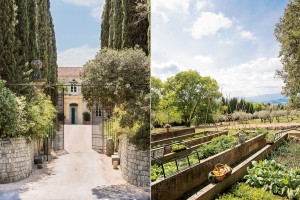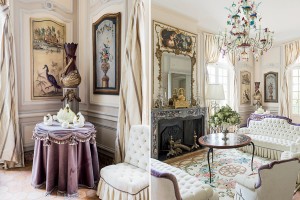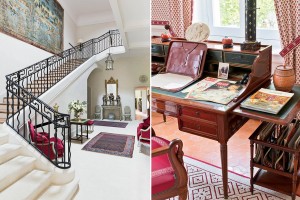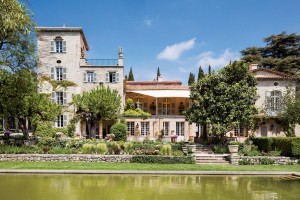The French designer created the most commanding silhouette of 20th-century fashion. Now the house where he found inspiration and respite has been masterfully refreshed and restored.
Handsome young men in straw hats and pristine aprons are tending Christian Dior’s garden. One flashes a photogenic smile as he clips the air with pruning shears. I’m not a horticulturist, but shouldn’t he be aiming at a plant? I later learn that the “gardeners” are models brought in to celebrate the reopening of Château de la Colle Noire, Dior’s country retreat, in the Provençal village of Montauroux, an hour northwest of Cannes. Dior lived in many houses—Les Rhumbs, in Granville; Le Moulin du Coudret at Milly-la-Forêt; a townhouse on Boulevard Jules-Sandeau in Paris, not to mention the House of Dior at 30 Avenue Montaigne. But there was no place like La Colle Noire. It whispered his famous name instead of shouting it. It gave him a place to hang his straw gardener’s hat, a place where he could be Dior, with all his neuroses, superstitions, and fantasies. It was, in short, home.
“Wow!” says Charlize Theron as she steps out of a black Mercedes, gazing at the vine-covered stone château. Christian Dior Parfums, under the auspices of the luxury company LVMH, purchased La Colle Noire in 2013 to use for private events. Theron, who is the face of J’adore, is wearing Dior couture, the flounced neckline of her streamlined dress creating a petal-like effect that evokes the designer’s love of flowers. She joins 200 other guests, including LVMH chairman Bernard Arnault, for dinner at a long table beneath a garden pergola. Michelin-starred chef Philippe Labbé (of Paris’s famed Tour d’Argent) prepared the menu, drawing inspiration from Dior’s favorite foods. (Bresse chicken with lemon confit for men, steamed sea bass with a fennel and bergamot emulsion for women.)
The evening ends with a fireworks display. When the last streak of light dissolves behind Dior’s ornamental pond, the guests disappear. As I’m about to leave, a “gardener” hands me a bouquet of lilies of the valley. It was Dior’s favorite flower. Mine too. Diorissimo, which was conceived at La Colle Noire and captures the bloom’s gentle scent, was my first “grown-up” perfume. My mother grew the flower in her garden and kept a blue glass cup decorated with the delicate white bells on her bureau. After she died and we sold the family home, the cup disappeared. I never found out what happened to it.

From left: the main entrance of the estate was designed by Dior; thyme, sorrel, and lettuce, among other crops, still grow in the vegetable garden on the south side of the estate.
Two days later, I’m back at La Colle Noire for a private tour. A driveway lined with cypress trees leads into a round hall decorated with a compass rose pattern composed of river pebbles. Dior copied the design from Les Rhumbs, his childhood home in Normandy, where he helped his elegant mother plant flowers in their garden. Dior’s father manufactured chemical fertilizer, and they lived a very comfortable bourgeois life. Dior had wanted to become an architect—his mother loved interior design—but his parents discouraged him. Eventually, Dior convinced his father to give him money to open an art gallery in Paris, where he showed Paul Klee, Max Ernst, Joan Miró, Salvador Dalí, and Pablo Picasso.
Dior’s charmed life ended when he was 25. His younger brother was committed to a psychiatric institute; his mother died a year later. As a result of the 1929 stock market crash, Dior’s father lost all his money, and Dior contracted tuberculosis and spent a year in a sanatorium. He came through the ordeal determined to follow his true passion, becoming an “ephemeral architect”—in other words, a couturier.
In 1947, Dior’s New Look made fashion history. After the utilitarian clothing of the war years, women embraced the opulent style, with its soft shoulders, cinched waists, and full swirling skirts. Dior’s original name for the collection was Corolle, which means circle of flower petals. He wanted to make clothes for “flower women” but wasn’t content to stick with one New Look. The silhouette changed with the seasons; sometimes he emphasized the bosom, other times the hips. For his last collection, he turned out narrow chemises and tunics. With his business partner, Jacques Rouët, he also pioneered lucrative licensing agreements, especially for perfume. The name Dior became world famous.

From left: a detail of the Petit salon shows Dior’s penchant for swans; the Petit salon, a decorative extension of the Grand salon, features 19th-century antiques and a Murano glass chandelier.
Fame was not without its burdens. Shy and anxiety-prone, Dior was temperamentally illsuited to handle the stress, channeling his fears into a dependency on fortune-tellers, mystics, and astrologers, lining his pockets with amulets and lucky charms, especially lilies of the valley. Dior, who loved fatty foods, had suffered two heart attacks while still in his 40s. He didn’t require a fortune-teller to tell him that he needed a place to decompress.
Dior purchased La Colle Noire in 1951 but didn’t begin work on it until 1954, the year he debuted his “lily of the valley” line, a collection that emphasized youth, grace, and simplicity. Collaborating with architect André Svetchine, who had remodeled Auberge de la Colombe d’Or in St.-Paul-de-Vence, he wanted a house that conveyed a sense of history and dignity. In his autobiography, Dior by Dior, he compared living in a place that didn’t suit the occupant to wearing someone else’s clothes. In the end, La Colle Noire was haute couture. It fit him to perfection. Sadly, Dior didn’t have much chance to enjoy it. He died of a heart attack in 1957. He was only 52.
Over the next half century, La Colle Noire fell into different hands, none as capable or exacting as Dior’s. When Dior Parfums rescued it, Frédéric Bourdelier, Dior’s heritage and brand expert, was given the daunting task of bringing the neglected property back to life.
I meet Bourdelier in the portrait gallery, where I’m confronted with multiple images of Dior. For the first time I realize I never knew what he looked like, or if I did, I’d completely forgotten. Unlike Coco Chanel, whose striking portraits in long pearls make an indelible impression, Dior, a portly man with a pasty face, bald head, and receding chin, hardly makes an impression at all. Looking more closely, however, I detect a merry gleam in his eyes. The little boy who fell in love with flowers shines through.

From left: the grand staircase with its original wrought iron railing; a restored Louis Seize desk in Dior’s office.
Bourdelier shows me a gold star made of tin. It’s a replica of the star Dior discovered on the Rue St.-Honoré on the day he was debating opening his own atelier. He took it as a good sign and the House of Dior was born. Stars are everywhere—on lampshades, quilts, above Dior’s bed, on his desk in the form of a starfish, on the wall as a starfish painting. Once Dior had determined something was lucky, he wasn’t shy about spreading that luck around.
Bourdelier, who has worked at Dior for 17 years, probably knows the designer better than almost anyone. In order to return Dior’s furniture and belongings to La Colle Noire, he went on a treasure hunt, tracking down at least half of the original items. “Dior’s sister Catherine inherited the house after Dior died,” he explains, “so we purchased many things at her auction.” Several of the rooms, such as the Provençal salon, Dior’s office, and the Egyptian room, with its vivid orange-and-green wallpaper, were restored to their original states.
Since Dior was still working on the house when he died, Bourdelier and decorator Yves de Marseille had to channel his spirit. “Luckily, we had a huge archive that we could consult,” Bourdelier says, “and we knew that Dior was drawn to a mix of rustic and sophisticated. He’d combine Louis Quinze with Provençal fabric. He wanted to make the place look as if it had been occupied by several generations of the same family.”
Bourdelier, in effect, was charged with creating Dior’s visual biography. The sophisticated couturier is evident in the Petit salon, with its cream-and-gray color scheme, Murano glass chandelier, Louis Seize console, and gilded mirrors. He’s also there in the magnificent wrought iron stair railing copied from his Avenue Montaigne atelier. Dior, the hedonist, can be found in the Directoire-and Empire-styled bathroom, with its Carrara marble bathtub and gold swan-neck taps. Swans are another recurrent theme. A symbol of elegance and also of eroticism, they bring to mind the Greek myth in which the god Zeus, in the form of a swan, seduces Leda.
Dior, the devoted brother, is on display in the lovely room he reserved for his sister Catherine, whose initials adorn the wrought iron headboard. Catherine is the original “Miss Dior,” for whom the perfume is named. A member of the Resistance during World War II, she was deported and sent to Ravensbrück, a women’s concentration camp in Germany. The French government eventually awarded her the Croix de Guerre.
Dior, the horticulturist, is apparent in the abundant flower arrangements, as well as the lush floral wallpaper. Dior, the gourmet, can be found in the large kitchen and in the simple but comfortable dining room, where he enjoyed giving dinner parties for small groups of friends, such as the artists Marc Chagall and Bernard Buffet and the art patron Marie-Laure de Noailles. Upstairs, Dior, the loyal friend, is represented in the rooms named for such intimates as fashion illustrators Christian Bérard and René Gruau, who did the striking advertisement of an elegant white swan with a black bow and pearls for Miss Dior fragrance. These are my favorite rooms in the house. I’d love to curl up on one of the beds and daydream the hours away.
Dior did most of his daydreaming outdoors. La Colle Noire originally comprised 126 acres, and Dior immediately set out planting rosebushes, jasmine, violets, lilies, and olive trees. As a couturier, Dior knew how clothes should move and he expected nothing less of the landscape. Olive trees swayed, vines oscillated, flowers danced. Today, the property consists of 12 acres, and while landscape architect Philippe Deliau couldn’t replicate the original plans, he kept the key elements, including planting 1,000 rosebushes and almond trees. Most important, he’s created an overall sense of relaxation and serenity.
It’s been raining for the past few days, and everything smells more pungent. Thanks to his mother, Dior was a born perfumer, and I’m sure he’d be pleased that François Demachy, the company’s in-house “nose,” has relocated his lab to nearby Grasse. Once the perfume capital of the world, Grasse has seen the production of flowers diminish as manufacturers have increasingly turned to synthetics. Dior Parfums is committed to reviving the ancient art, as well as the local economy, collaborating with two local flower fields: Domaine de Manon and Clos de Callian.
At lunch a day earlier, I’d sat next to Armelle Janody, who owns Clos de Callian with her husband. They both gave up their jobs—she was a teacher, he worked in TV—to devote their lives to growing roses such as the ones that form the top note of La Colle Noire, the latest addition to Dior’s Collection Privée. The rose has to be picked on the day it blooms or it can’t be used. Janody speaks so passionately about her roses that I begin to wonder if maybe I should devote my life to flowers too. But then she talks about battling insects, and I think, maybe not.
Before I leave La Colle Noire, I ask Bourdelier if I can wander through the house on my own. I’m not sure what I’m looking for. Dior’s ghost? Employees at his Avenue Montaigne atelier have claimed they often feel his presence, as if he’s checking on their work. Throughout the day the Joni Mitchell song “Both Sides Now” has been playing in my head. I think of the line, “It’s life’s illusions I recall, I really don’t know life at all.” Dior knew life, but he felt more at home with its illusions—lucky gold stars, lilies of the valley, Greek gods turned into swans.
As I walk through the upstairs guest bedrooms, admiring Gruau’s drawings and Bérard’s watercolors, I find myself in the Chagall room. I’d missed it before. It’s decorated in shades of blue and gray, with bamboo-style furniture. I turn away from the bed, which is framed by two Chagall drawings, and toward the matching bureau. It is then that I see it: my mother’s blue lily of the valley cup.
Some objects have a way of finding their way home. It may be a different home. It may be a slightly different object. But right now, standing in this house of splendid illusion, I hear Dior whisper, “Good luck.”
Photographs by Stephan Julliard

